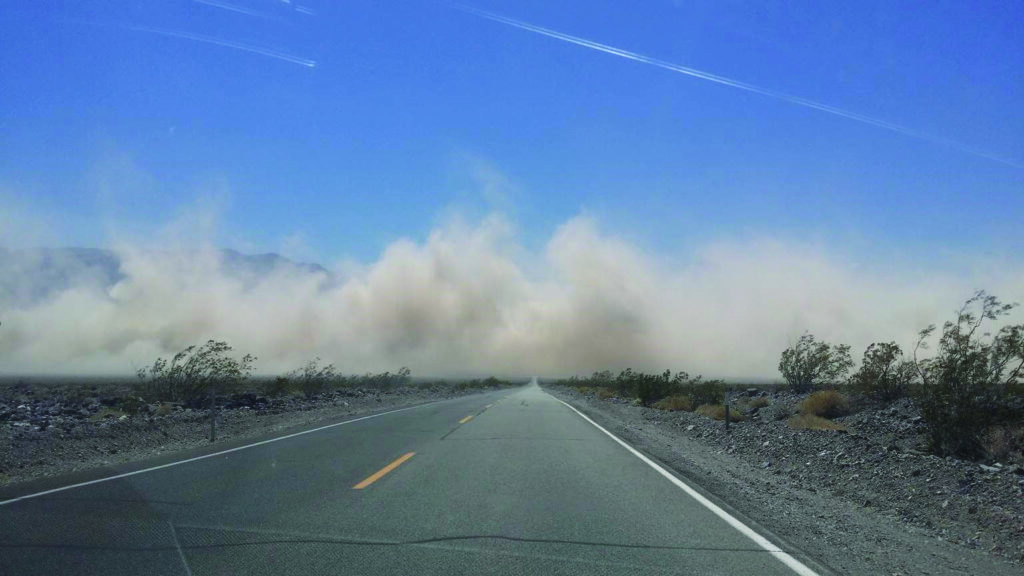I’ll never forget…
…being trapped in a zero-visibility sandstorm in Death Valley
We had a day off from testing, so we decided to make the most of it by going to inspect a route in the Death Valley area for assessing thermal stress on the brake system, which would normally focus on ‘vapor lock’ phenomena caused by high temperatures on the friction material. Local OEMs perform such thermal tests on the Death Valley descents, similar to those done in the Alps, and we wanted to understand the main differences.
The day started very calmly. It was sunny with extremely high temperatures typical of the area in mid-August, so we left our accommodation in Santa Clarita early in the morning with four long hours on the road ahead.
After checking out the test route, we started to head back to Santa Clarita. At the descent through Panamint Valley a few locals had stopped their vehicles at the side of the road. They warned us not to continue along the road as a sandstorm was looming at the bottom of the valley, which would make it very difficult to proceed. We asked how long the storm might last. They replied, “Perhaps a few hours.”
We were unfamiliar with the meteorological phenomena in the area, and the alternative return route to Santa Clarita involved a six-hour journey, so we decided to carry on with our planned descent through the valley. According to the maps, the column of dust and sand we could see directly in front of us stretched over the road for only about 2km. That seemed doable.
We were expecting something like a typical Mediterranean end-of-summer rainstorm, with moderately strong winds and slightly reduced visibility. Just before entering the dense ‘rain’, we turned off the air-con and closed the ventilation ducts to prevent the sand and dust entering the car. Even though it was 42°C outside, traveling just 2,000m without cold air didn’t strike us as a big problem.
As we approached the storm, the light coming through the windshield and windows began to turn a pale yellow. Then grayish darkness surrounded us, making it almost impossible to see beyond the nose of the car. We got more and more nervous and panicked, particularly when we suddenly saw two large shadows just centimeters away from the vehicle. They were two vehicles that had collided in the opposite lane due to the lack of visibility. The drivers were standing on the road and had their heads covered with makeshift turbans, more typical of Saharan Tuaregs than Californians.
As we drove through the mass of dust, the noise became more and more deafening and the force of the wind buffeted the car. Suddenly, the acoustic signals from the front sensors warned of an obstacle close by. It was another vehicle parked on what we believed to be the hard shoulder. This time we couldn’t tell whether there were people with the vehicle or not. We were now extremely aware of the danger and our vulnerability, and we were worried we could hit another stranded vehicle or run off the road. The roar of the wind and lack of visibility meant we could hardly tell if the car was actually moving. We decided to stop on what we guessed to be the roadside and think about how to get out of this hell on Earth. As the minutes went by, the temperature inside the car became unbearable and we were soaked in sweat.
After about 30 minutes, still trapped by the storm, we set off again to try to drive ourselves out of danger. We had to work as a team. Bernat in the driver’s seat was in charge of accelerating slowly and checking that the vehicle was actually moving by looking at the odometer. I was in the passenger seat, and took the wheel and tried to keep the car in the lane, guided by the little I could see through my window. José, in the back seat, kept an eye open for any movement or shadows he could make out through the windshield. We used the acoustic parking sensors as the only certain way of detecting objects around us. We were finally moving forward, slowly but surely.
The sky gradually began to turn a more vivid gray tone. The storm was finally clearing, and blue sky was just a few meters ahead. It had taken more than half an hour to cover about 1,500m. As we came out of the storm, we saw a sheriff’s car blocking the way into the dust. We celebrated that we were safe and reflected on how foolish we’d been to ignore the locals’ advice and disregard the danger of a sandstorm. It was the slowest and most exhausting 2km we’d ever driven.
Callum Brook-Jones spoke to Roger Mateu, head of braking systems, Applus Idiada.


